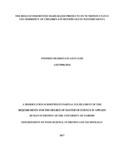| dc.description.abstract | Introduction: Most of the rural communities in Kenya heavily depend on maize based products as a weaning diet for children less than five years. Fermented maize based foods constitute a substantial part of the diet in many African countries yet information on their consumption, quality and influence on nutrition status and morbidity of children under five years remain limited in Kenya. The current study sought to determine and document the role of fermented maize based products to nutrition status and morbidity of children 6- 59 months old in Homa Bay and Kakamega Counties.
Methodology:A structured questionnaire was used to collect socio- economic data, anthropometric measurements and 24- hour food recall in 120 households. Samples were collected from two localities in Homabay and Kakamega Counties and analyzed in the laboratory for contaminants (Staphylococcus aureas, coliforms and aflatoxin) and nutritive value (phytates, proteins, crude fibre, zinc, and iron). The samples collected included maize flour, soaked maize flour, cooked fermented porridge porridge fermented roasted (Mkarango) product and beverage (busaa).
Results: The mean weight of the children was 14.5 kilograms, while mean height and age were 90.9 centimetres and 32 months respectively. Child nutrition status was above average, those who were severely underweight, stunted and wasted were 6.7%, 21% and 9.2%, respectively. There was a high mean individual dietary diversity of 6.5 for Kakamega County and Homa Bay. Of the children accessed 50% had been sick two weeks prior to the study. Sources of water for household use were varied: 5.8% had tap water and 5.0% from boreholes, 46.7% from rivers, 22.5% from springs, 13.3% from protected wells and 6.7% from unprotected wells. 55% of the population used chemical for water treatment and 33.3% did not dispose-off child feaces
xvi
hygienically. The mean phytates content ranged from 3040- 3480mg/100gm in soaked flour and maize flour. The mean iron content was 1.26/100gm to 5.4mg/100gm in mkarango and fermented cooked porridge which had significant difference at p< 0.05. Zinc content in the maize products ranged between 2.17mg/100gm in maize flour to 4.9 mg/100gm in busaa. The contents of crude protein ranged 2.9% -14.4% in fermented porridge and busaa. The mean crude fibre content ranged from 2.8- 3.5% in fermented cooked uji and flour. The mean Staphylococcus aureus load on the products ranged from 3.4- 5.5 log cfu/g in mkarango and unfermented
Conclusion: Most household consume fermented porridges as family food but few use it as complementary food. Untreated water from unprotected flowing rivers and springs is used in preparation fermented maize products. The nutrient quality of fermented maize product is better than the unfermented ones. Most of the consumed fermented maize products that are handled unhygienically hence heavily contaminated.
Recommendation: Maize is a major food staple in Kenya, mostly utilized as a weaning diet in form of unfermented thin porridge. For fermented maize products to be accepted as weaning diet for the under five years, a strong campaign to inform care givers on the on benefits of fermentation is a need. | en_US |



